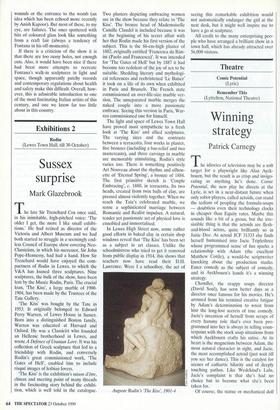Exhibitions 2
Rodin (Lewes Town Hall, till 30 October)
Sussex surprise
Mark Glazebrook
The late Sir Trenchard Cox once said, in his inimitable, high-pitched voice: The older I get, the more I like small exhibi- tions.' He had retired as director of the Victoria and Albert Museum and we had both started to struggle in a seemingly end- less Council of Europe show covering Neo- Classicism, in which his successor, Sir John Pope-Hennessy, had had a hand. How Sir Trenchard would have enjoyed the com- pactness of Rodin in Lewes, to which the V&A has loaned three sculptures. Nine sculptures, the bulk of the show, have been lent by the Musee Rodin, Paris. The crucial loan, 'The Kiss', a large marble of 1900- 1904, has been made by the Trustees of the Tate Gallery.
'The Kiss' was bought by the Tate in 1953. It originally belonged to Edward Perry Warren, of Lewes House in Sussex. Born into a distinguished Boston family, Warren was educated at Harvard and Oxford. He was a Classicist who founded an Hellenic brotherhood in Lewes, and wrote A Defence of Uranian Love. It was his collection of Greek sculpture that led to a friendship with Rodin, and conversely Rodin's great commissioned work, 'The Gates of Hell', enabled him to include risque images of lesbian lovers.
'The Kiss' is the exhibition's raison d'etre, climax and meeting point of many threads in the fascinating story behind the exhibi- tion, which is well told in the catalogue. Two plasters depicting embracing women are in the show because they relate to 'The Kiss'. The bronze head of Mademoiselle Camille Claudel is included because it was at the beginning of his secret affair with her that Rodin made his first version of the subject. This is the 86-cm-high plaster of 1882, originally entitled 'Francesca da Rim- ini (Paolo and Francesca)'. It was intended for 'The Gates of Hell' but by 1887 it had become too redolent of the joy of sex to be suitable. Shedding literary and mythologi- cal references and rechristened 'Le Baiser' it took on a life of its own when exhibited in Paris and Brussels. The French state commissioned an over-life-size marble ver- sion. The unseparated marble merges the naked couple into a more passionate embrace. Seeing this version in Paris, War- ren commissioned one for himself.
The light and space of Lewes Town Hall have proved most sympathetic to a fresh look at 'The Kiss' and allied sculptures. The varying sizes and the contrasts between a terracotta, four works in plaster, five bronzes (including a bas-relief and two mastercasts), and three carvings in marble are memorably stimulating. Rodin's style varies too. There is something positively Art Nouveau about the rhythm and silhou- ette of 'Eternal Spring', a bronze of 1884. The first primitive sketch is 'Couple Embracing', c. 1880, in terracotta., Its two heads, created from twin balls of clay, are pressed almost violently together. When we reach the Tate's celebrated marble, we sense a sophisticated marriage between Romantic and Realist impulses. A natural, tender yet passionate act of physical love is ennobled and immortalised.
In Lewes High Street now, some rather good efforts in baked clay in certain shop windows reveal that 'The Kiss' has been set as a subject in art classes. Unlike the schoolmistress who tried to get it removed from public display in 1914, this shows that teachers now have read their D.H. Lawrence. Were I a schoolboy, the act of
Augu.sie Rodin's I IN, kiss; 1901-4
seeing this remarkable exhibition would not automatically endanger the girl at the next desk, but it might well inspire me to have a go at sculpture.
All credit to the many enterprising peo- ple who have arranged a brilliant show in a town hall, which has already attracted over 56,000 visitors.


















































































 Previous page
Previous page